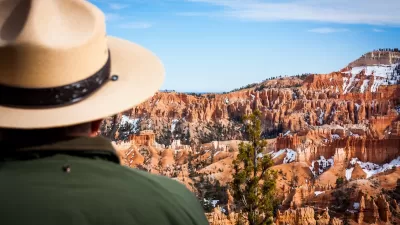The Department of Energy is proposing to construct massive "energy corridors", land designated solely for the purpose of energy conduction like oil, hydrogen and electricity.
"Energy production and distribution is a problem in the United States. To help solve the problem, the federal government has proposed the creation of energy corridors, areas of land where the infrastructure needed to move energy resources including hydrogen, oil, natural gas, and electricity will be constructed. According to Nada Culver, senior counsel in the Wilderness Society's Denver office, "Once designated, the corridors (averaging 3,500 feet wide but ranging up to five miles in width) will cover 6,000 miles and almost three million acres of public lands. Areas within the designated corridors are essentially deemed appropriate for pipelines and power lines, with expedited construction applications and limited environmental review." The official goal of the proposed corridors is to improve the reliability and availability of energy resources specifically in the Western U.S. Though the government's proposal-called the West-wide Energy Corridor project-may help provide energy to the states where the corridors are proposed, the government intends to construct them in federally protected lands, launching a debate over whether the corridors can be created in such a way that they avoid protected areas while taking local concerns into account."

Planetizen Federal Action Tracker
A weekly monitor of how Trump’s orders and actions are impacting planners and planning in America.

Maui's Vacation Rental Debate Turns Ugly
Verbal attacks, misinformation campaigns and fistfights plague a high-stakes debate to convert thousands of vacation rentals into long-term housing.

Restaurant Patios Were a Pandemic Win — Why Were They so Hard to Keep?
Social distancing requirements and changes in travel patterns prompted cities to pilot new uses for street and sidewalk space. Then it got complicated.

In California Battle of Housing vs. Environment, Housing Just Won
A new state law significantly limits the power of CEQA, an environmental review law that served as a powerful tool for blocking new development.

Boulder Eliminates Parking Minimums Citywide
Officials estimate the cost of building a single underground parking space at up to $100,000.

Orange County, Florida Adopts Largest US “Sprawl Repair” Code
The ‘Orange Code’ seeks to rectify decades of sprawl-inducing, car-oriented development.
Urban Design for Planners 1: Software Tools
This six-course series explores essential urban design concepts using open source software and equips planners with the tools they need to participate fully in the urban design process.
Planning for Universal Design
Learn the tools for implementing Universal Design in planning regulations.
Heyer Gruel & Associates PA
JM Goldson LLC
Custer County Colorado
City of Camden Redevelopment Agency
City of Astoria
Transportation Research & Education Center (TREC) at Portland State University
Jefferson Parish Government
Camden Redevelopment Agency
City of Claremont




























